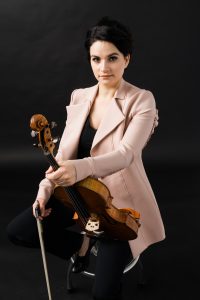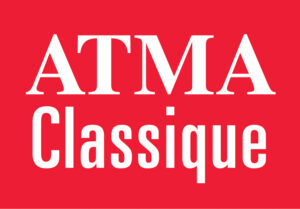
Violist Marina Thibeault holds numerous honours and distinctions, including prizes from the Père-Lindsay Foundation, “Révélation Radio-Canada”, and the Sylva Gelber Foun¬dation. In 2015 she won first prize in the string category of Prix d’Europe and the McGill Concerto Competition. ELLES, Marina’s second recording for ATMA Classique, features repertoire for solo viola and viola and piano (Marie-Eve Scarfone) by exceptional 19th and 21st century women composers including Clara Schumann, Fanny Hensel, Nadia Boulanger, Rebecca Clarke, Lilian Fuchs, and Anna Pidgorna. ELLES will be released on March 8, International Women’s Day
1. How did music first enter your life?
When I was 6 years old, I had a fiddler neighbour who was about 80 years old. He would sit on his porch and play Quebec folk tunes for hours in the summer time. I used to bring my little red plastic chair outside and listen to him from my backyard. The following Christmas, I got my first violin and made my family do square-dances quite early in my musical journey!
2. You were the youngest student (just 9 years old!) to enter the Conservatoire de Musique de Québec. What was that experience like?
I loved being surrounded by the older students. Most of my classmates for solfege, music history and orchestra were in college. They really looked after me. The challenging part was going to regular school with people my own age. I had every afternoon off and went to the Conservatoire to practice and take classes, and I remember dreaming of “after-lunch”! It very much felt like I had two lives!
3. Who has been your most important mentor, musical or otherwise?
Michael Tree, indubitably. His musicianship, kindness, rigor, patience, listening… I still pinch myself that I got to study with him for 4 years at the Curtis Institute of Music. His lessons went beyond playing the viola. He taught his students how to nurture every phrase musically, how to use our technique to serve the music and most importantly, he was the perfect example of how to honour high musical standards while being a good human and colleague. His sound was so warm and bewitching. I can still remember perfectly the earthiness of his c string in my ear…
4. In a recent interview you said, “I believe the viola is now in its golden era”. Can you elaborate on that statement for our readers?
With the arrival of great violists came great repertoire. First in England with Lionel Tertis and William Primrose, then with Russian violist Yuri Bashmet, and today with Tabea Zimmermann and Kim Kashkashian. The last two had strong relationships with Ligeti and Kurtag respectively, and contributed immensely to the evolution of viola technique and musical advancement.
It is our responsibility as performers to ensure the place of the viola as a solo instrument by working with today’s composers. We get to shape the instrument and its development. Its colors our earthy, rich, warm, sensual and good violists are taking over the music world!
5. What are the most common misconceptions people have about the viola?
There are a lot of unconventional aspects to the viola. Its size is odd. Some call it a big violin or a small cello. 300 years ago, its dimensions were so big it was called a tenor. It was so large that composers attributed it very simple accompaniment lines, because the instrument was so hard to manage. With “uninteresting” lines, not many people felt drawn to the viola. Hence why it was often played by poor violinists. The modern viola are smaller and vintage instruments are often cut down, which makes it easier to get around for virtuoso passages.
6. Tell us about the special 18th century instrument you play.
I am very grateful to have played on various fine instruments in past years, thanks to the Canimex group. They first loaned to me a beautiful and tiny Vuillaume (which I performed on for my first album Toquade), then a Landolfi from its golden year (which I used for the ELLES album) and just before Christmas, I received a large Ferdinando Alberti Milan, v. 1760, which has such a profound sound. I feel so spoiled!
7. Your repertoire includes a fair bit of music by contemporary composers. Is this a choice deliberate on your part, and if so, why?
Absolutely. I would say that this repertoire is why I chose to play the viola in the first place. I was always drawn by the 20th century music. On my way to high school, I would blast Shostakovich and Stravinsky violin concerti in my mom’s car! She was so kind to bear with me during that period!
Curtis strongly encouraged instrumental students to mingle with student composers. I collaborated with many of them, and in the last 2 years of my study there, I was part of the 20/21 string quartet. We had the chance to play for Joan Tower, John Corigliano, Krzysztof Penderecki, and I truly enjoyed working with living composers. They were always so humble about their work. Composers are real humans and most of them give a lot of liberty to the performers. We need one another to realize ourselves artistically, and this bond is very fulfilling. Working with today’s composers also helps us learn how to approach composers from the past centuries.
8. Where do you turn for inspiration to help you grow as an artist?
About once or twice a year, I take the plane to go to London to play for someone very special. David Takeno is one of the most inspiring pedagogue of our time. Whenever I am breaking in a concerto or new repertoire for a recording, I go and play for him.
In February 2018, I lived in his basement, had lessons, watched the PyeongChang Olympics and practiced intensely for 3 days. It was the best viola retreat I could have imagined.
9. If music had not been possible as a career, what would you most likely be doing now?
In high school, my three options were: 1) Curtis 2) Juilliard 3) Quebec Police school! I got into all three and music won over getting people arrested… however I do give my students speeding tickets once in a while!
In all seriousness, I think I would also be very happy working in the fashion industry. Wearing art and incorporating it into our daily lives fascinates me. I would love to import eco-friendly and fair-trade fabrics and make my own clothing designs.
10. Tell us about your beautiful tattoo. Is there a special meaning behind the design?
Back in 2012, I did a yoga teacher training at the Sivananda Yoga Ashram in Val Morin, Quebec, and it was such a transformative experience that I wanted a permanent reminder. I have the “om” symbol on my forearm, which is the sound of the creation of the earth, and flowers are blossoming out of it. Inside my wrist, I have my secret meditation mantra in Sanskrit!
11. What upcoming projects are on the horizon for you?
My second album will be out on March 8th, International Women’s Day. The program consists entirely of pieces written by women composers. I wanted to honour the women in music who changed the past centuries, as performers, pedagogues and composers. I will take excerpts of the CD on tour to the US in the spring (Cleveland, LA, Long Island). I also look forward to making the North American premiere of the Vasks Viola concerto with Sinfonia Toronto in April. There are plans to record this concerto with I MUSICI for my third album.
I will be the soloist in residence of the Orchestre de la Francophonie this summer, reviving Gilles Tremblay’s En Partage for viola and orchestra. This work was only played once for its premiere with Rivka Golani, Charles Dutoit and the OSM. We will play En Partage at the National Arts Centre, the Domaine Forget, and at a new festival in the Laurentians. The Domaine Forget performance will also include Mozart’s Sinfonia Concertante which I will play alongside the great Canadian violinist Kerson Leong.
12. Anything else you’d like readers to know?
I got obsessively into knitting this summer and recently started to sew my own clothes. You might see me on stage wearing something I have made! My hands like to keep busy while not playing the viola!
